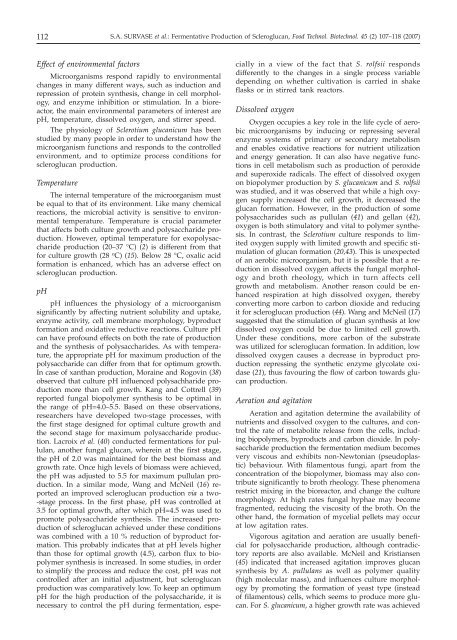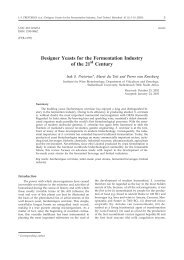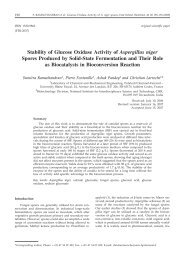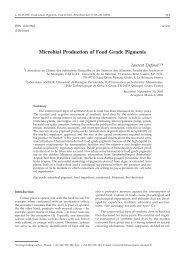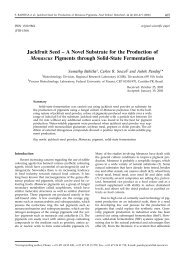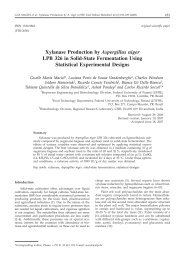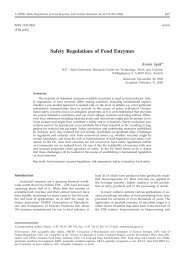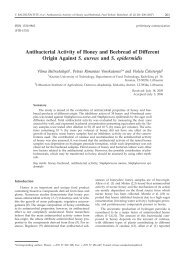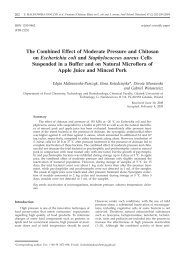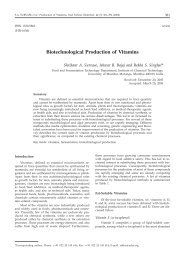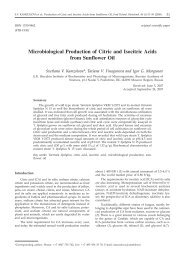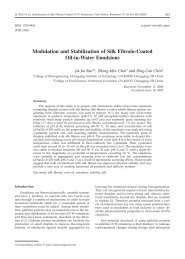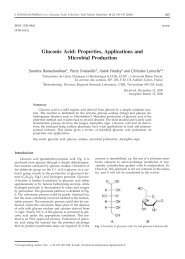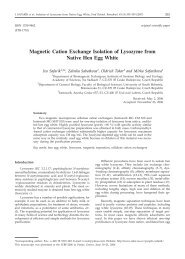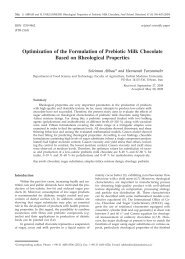Scleroglucan - Food Technology and Biotechnology
Scleroglucan - Food Technology and Biotechnology
Scleroglucan - Food Technology and Biotechnology
You also want an ePaper? Increase the reach of your titles
YUMPU automatically turns print PDFs into web optimized ePapers that Google loves.
112 S.A. SURVASE et al.: Fermentative Production of <strong>Scleroglucan</strong>, <strong>Food</strong> Technol. Biotechnol. 45 (2) 107–118 (2007)<br />
Effect of environmental factors<br />
Microorganisms respond rapidly to environmental<br />
changes in many different ways, such as induction <strong>and</strong><br />
repression of protein synthesis, change in cell morphology,<br />
<strong>and</strong> enzyme inhibition or stimulation. In a bioreactor,<br />
the main environmental parameters of interest are<br />
pH, temperature, dissolved oxygen, <strong>and</strong> stirrer speed.<br />
The physiology of Sclerotium glucanicum has been<br />
studied by many people in order to underst<strong>and</strong> how the<br />
microorganism functions <strong>and</strong> responds to the controlled<br />
environment, <strong>and</strong> to optimize process conditions for<br />
scleroglucan production.<br />
Temperature<br />
The internal temperature of the microorganism must<br />
be equal to that of its environment. Like many chemical<br />
reactions, the microbial activity is sensitive to environmental<br />
temperature. Temperature is crucial parameter<br />
that affects both culture growth <strong>and</strong> polysaccharide production.<br />
However, optimal temperature for exopolysaccharide<br />
production (20–37 °C) (2) isdifferentfromthat<br />
for culture growth (28 o C) (15). Below 28 °C, oxalic acid<br />
formation is enhanced, which has an adverse effect on<br />
scleroglucan production.<br />
pH<br />
pH influences the physiology of a microorganism<br />
significantly by affecting nutrient solubility <strong>and</strong> uptake,<br />
enzyme activity, cell membrane morphology, byproduct<br />
formation <strong>and</strong> oxidative reductive reactions. Culture pH<br />
can have profound effects on both the rate of production<br />
<strong>and</strong> the synthesis of polysaccharides. As with temperature,<br />
the appropriate pH for maximum production of the<br />
polysaccharide can differ from that for optimum growth.<br />
In case of xanthan production, Moraine <strong>and</strong> Rogovin (38)<br />
observed that culture pH influenced polysachharide production<br />
more than cell growth. Kang <strong>and</strong> Cottrell (39)<br />
reported fungal biopolymer synthesis to be optimal in<br />
the range of pH=4.0–5.5. Based on these observations,<br />
researchers have developed two-stage processes, with<br />
the first stage designed for optimal culture growth <strong>and</strong><br />
the second stage for maximum polysaccharide production.<br />
Lacroix et al. (40) conducted fermentations for pullulan,<br />
another fungal glucan, wherein at the first stage,<br />
the pH of 2.0 was maintained for the best biomass <strong>and</strong><br />
growth rate. Once high levels of biomass were achieved,<br />
the pH was adjusted to 5.5 for maximum pullulan production.<br />
In a similar mode, Wang <strong>and</strong> McNeil (16) reported<br />
an improved scleroglucan production via atwo-<br />
-stage process. In the first phase, pH was controlled at<br />
3.5 for optimal growth, after which pH=4.5 was used to<br />
promote polysaccharide synthesis. The increased production<br />
of scleroglucan achieved under these conditions<br />
was combined with a 10 % reduction of byproduct formation.<br />
This probably indicates that at pH levels higher<br />
than those for optimal growth (4.5), carbon flux to biopolymer<br />
synthesis is increased. In some studies, in order<br />
to simplify the process <strong>and</strong> reduce the cost, pH was not<br />
controlled after an initial adjustment, but scleroglucan<br />
production was comparatively low. To keep an optimum<br />
pH for the high production of the polysaccharide, it is<br />
necessary to control the pH during fermentation, especially<br />
in a view of the fact that S. rolfsii responds<br />
differently to the changes in a single process variable<br />
depending on whether cultivation is carried in shake<br />
flasks or in stirred tank reactors.<br />
Dissolved oxygen<br />
Oxygen occupies a key role in the life cycle of aerobic<br />
microorganisms by inducing or repressing several<br />
enzyme systems of primary or secondary metabolism<br />
<strong>and</strong> enables oxidative reactions for nutrient utilization<br />
<strong>and</strong> energy generation. It can also have negative functions<br />
in cell metabolism such as production of peroxide<br />
<strong>and</strong> superoxide radicals. The effect of dissolved oxygen<br />
on biopolymer production by S. glucanicum <strong>and</strong> S. rolfsii<br />
was studied, <strong>and</strong> it was observed that while a high oxygen<br />
supply increased the cell growth, it decreased the<br />
glucan formation. However, in the production of some<br />
polysaccharides such as pullulan (41) <strong>and</strong> gellan (42),<br />
oxygen is both stimulatory <strong>and</strong> vital to polymer synthesis.<br />
In contrast, the Sclerotium culture responds to limited<br />
oxygen supply with limited growth <strong>and</strong> specific stimulation<br />
of glucan formation (20,43). This is unexpected<br />
of an aerobic microorganism, but it is possible that a reduction<br />
in dissolved oxygen affects the fungal morphology<br />
<strong>and</strong> broth rheology, which in turn affects cell<br />
growth <strong>and</strong> metabolism. Another reason could be enhanced<br />
respiration at high dissolved oxygen, thereby<br />
converting more carbon to carbon dioxide <strong>and</strong> reducing<br />
it for scleroglucan production (44). Wang <strong>and</strong> McNeil (17)<br />
suggested that the stimulation of glucan synthesis at low<br />
dissolved oxygen could be due to limited cell growth.<br />
Under these conditions, more carbon of the substrate<br />
was utilized for scleroglucan formation. In addition, low<br />
dissolved oxygen causes a decrease in byproduct production<br />
repressing the synthetic enzyme glycolate oxidase<br />
(21), thus favouring the flow of carbon towards glucan<br />
production.<br />
Aeration <strong>and</strong> agitation<br />
Aeration <strong>and</strong> agitation determine the availability of<br />
nutrients <strong>and</strong> dissolved oxygen to the cultures, <strong>and</strong> control<br />
the rate of metabolite release from the cells, including<br />
biopolymers, byproducts <strong>and</strong> carbon dioxide. In polysaccharide<br />
production the fermentation medium becomes<br />
very viscous <strong>and</strong> exhibits non-Newtonian (pseudoplastic)<br />
behaviour. With filamentous fungi, apart from the<br />
concentration of the biopolymer, biomass may also contribute<br />
significantly to broth rheology. These phenomena<br />
restrict mixing in the bioreactor, <strong>and</strong> change the culture<br />
morphology. At high rates fungal hyphae may become<br />
fragmented, reducing the viscosity of the broth. On the<br />
other h<strong>and</strong>, the formation of mycelial pellets may occur<br />
at low agitation rates.<br />
Vigorous agitation <strong>and</strong> aeration are usually beneficial<br />
for polysaccharide production, although contradictory<br />
reports are also available. McNeil <strong>and</strong> Kristiansen<br />
(45) indicated that increased agitation improves glucan<br />
synthesis by A. pullulans as well as polymer quality<br />
(high molecular mass), <strong>and</strong> influences culture morphology<br />
by promoting the formation of yeast type (instead<br />
of filamentous) cells, which seems to produce more glucan.<br />
For S. glucanicum, a higher growth rate was achieved


